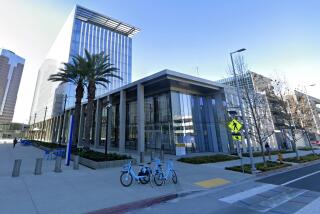City Weighs $25 Fines for Wasting Water : Conservation: Council is scheduled to act Tuesday on mandatory cutbacks based on average household use.
- Share via
LONG BEACH — Washing the driveway or watering the lawn during the day could cost Long Beach residents another $25 on their water bills starting March 1, when the first phase of the city’s mandatory water conservation plan is likely to go into effect.
In a proposal scheduled to go before the City Council for final approval Tuesday, even more severe financial penalties for wasting water would be in place by May 1.
In drafting plans to cut water consumption in the fifth winter of a worsening statewide drought, local water officials are taking a slightly different approach than their counterparts in Los Angeles. There, residents would be asked to cut their water use by 15% of their 1986 consumption levels under a recent proposal.
But in Long Beach, the conservation guidelines would instead be pegged to average household use.
“We don’t want to penalize people who have already conserved,” explained John Hough, administrative officer of the city Water Department. “We don’t think a flat percentage rate reduction is equitable for someone who has already taken steps (to save water) . . . The intent of the program is to get the attention of people who are using more than the average.”
That average figure, about 374 gallons a day for a single-family residence, is based on consumption during the past year, when a call for voluntary conservation efforts already had lessened the city’s thirst by about 4% to 5%.
Since it will take the Water Department until May 1 to incorporate financial penalties for excessive use into its billing system, the new household rationing would not go into effect until then.
In the meantime, the Water Department as of March 1 proposes to tack $25 onto the water bill of customers reported for:
* Hosing down walkways, driveways or parking areas.
* Failing to repair leaks.
* Watering lawns or landscaping between the hours of 10 a.m. and 4 p.m. or watering lawns to the point that the water runs off.
* Letting a hose run continuously while washing vehicles.
* Serving drinking water to restaurant customers unless requested by the customer.
* Maintaining a decorative fountain with water that is not recycled.
To catch violators, the Water Department plans to send out drought-buster patrols that will drive around the city looking for soggy lawns and running hoses.
The household rationing plan includes four different levels of conservation, any of which the department could choose to put into effect in May.
The least severe calls for a single-family residence to hold its water use to the average level, about 374 gallons a day. Additional water usage would be billed at 1 1/2 times the normal rate.
The strictest rationing would require a single-family residence to use no more than about 300 gallons a day. Additional use would be billed at four times the normal rate.
The allocations for apartments and duplexes will be slightly less, based on the assumption that the average number of residents is fewer than in a house and that there are fewer landscaping needs.
Depending on the rationing plan adopted in May, commercial and industrial users would be asked to cut their consumption by 10% to 30% of the amount they used annually before the voluntary conservation program went into effect last spring. Excess use would be billed at the same rates as residential customers.
Customers could appeal the conservation limits if, for instance, they have an unusually large number of people living in the home or, in the case of a business, the restrictions would put employees out of work.
The Long Beach Water Department gets 60% of its water from the Metropolitan Water District, which is confronted this winter with nearly empty reservoirs and extraordinarily low snowpacks in the Sierra Nevada, which supplies Southern California with much of its water.
More to Read
Sign up for Essential California
The most important California stories and recommendations in your inbox every morning.
You may occasionally receive promotional content from the Los Angeles Times.











